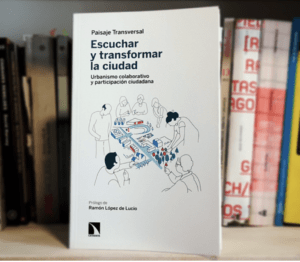Throughout my research with Paisaje Transversal, I have relied primarily on documentation provided by them which include their 3rd edition to their book “Escuchar y Transformar la Ciudad” and their blog. With these resources, I have been able to analyze the complexities of their projects that pertain to the gamification approach. As well as, understating the different neighborhoods of the City of Madrid and how they have been affected by the COVID-19 pandemic.
I first began reading their new edition of their book that was released this year, “Escuchar y Transformar la Ciudad: Urbanismo colaborativo y participación ciudadana,” (Listening and Transform the City: Collaborative Urbanism & Citizen Participation). The book was first published in 2018 and since then it has received amazing feedback. The book is divided into three chapters, each describes issues and opportunities on different scaled. The first is at the neighborhood level, such as a public plaza. The second chapter focuses on a mid-level initiative, such as community or city transformation. Finally, the third chapter examines a large-scale initiative that focuses on the regeneration and design of a whole region or territory in a given area.
This book has become a go-to guide to understand Paisaje Transversal’s methodologies and strategies towards their urban regeneration projects. The authors of the book discuss how cities have taken a central role in global geopolitics and the future of humanity. This is why they believe it is essential to rethink the way we plan and transform cities around the world. The book functions as a review of the origin of urban issues, as well as to understand and apply new ways to fix the issues in a more participatory perspective. This book has been very helpful in understanding how the gamification approach was successful in their projects.
Another resource that I have relied on has been their blogs. Paisaje Transversal has been able to post about the base of their current projects on urban issues and their solutions. Having little knowledge on Madrid, Spain, their blog. has helped me navigate through their neighborhoods and view their perspective about it. In the next couple of weeks, I will still be using their book as a reference as well as their blog in order to understand more about vulnerable communities in Madrid, Spain.

